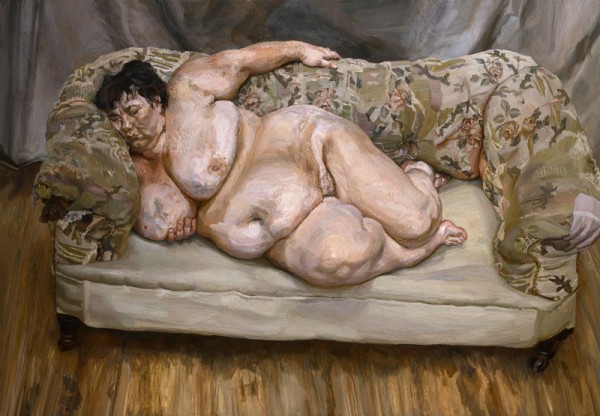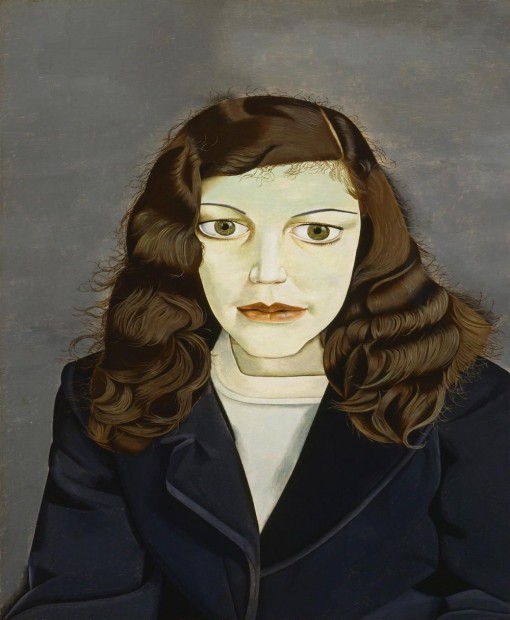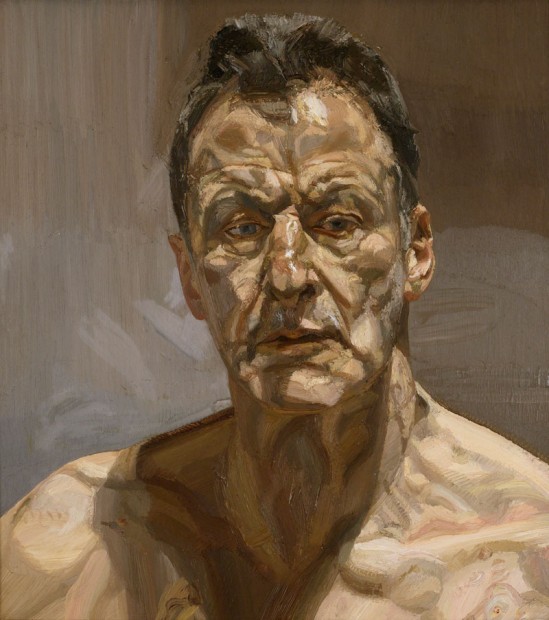
Lucian Freud. “Benefits Supervisor Sleeping,” 1995, Private Collection © The Lucian Freud Archive,Image copyright: Courtesy Lucian Freud Archive
The Modern Art Museum of Fort Worth is the only U.S. venue for Lucian Freud: Portraits. If you haven’t seen it yet, go now. It closes this Sunday, October 28th. It’s a stunning exhibition, covering portraits from the late 1940s until just before his death last year at age 88.
Arranged chronologically, the show opens with Freud’s crisp, clean and almost stroke-free early portraits. They have a cool, Netherlandish light and the feeling of a contemporary Van Eyck. But the space and the figures themselves are slightly flattened and distorted – Freud wasn’t ever seeking objective realism. His work has always been psychologically infused. His portraits of his first wife, Kitty Garman, date from just after the end of WWII. Garman is the woman with the large, slightly bulging eyes. She stares toward the viewer in Girl in a Dark Jacket, (1947) but she really isn’t looking at you. Freud has masterfully captured his subject staring into space, her eyes unfocused, consumed by her own thoughts. He has painstakingly rendered the tiny stray strands of her long dark wavy hair while her poreless flesh has a greenish cast. Other images show his wife clasping a flower or holding a kitten but here is nothing particularly soft or tender. She looks so tense and lost in thought that is seems she might accidentally strangle the tiny animal clasped in her hand. These frozen portraits manage to hum with anxiety.

Lucian Freud, “Girl in a Dark Jacket,” 1947. Courtesy of the Lucian Freud Archive and the National Portrait Gallery.
But you wonder whether that anxiety is in inherent in the sitter or if it reflects the grim reality of postwar England. Freud’s family were Jewish refugees, fleeing from Germany in 1933 when Freud was 10 years old. They were joined by his grandfather, Sigmund (yes, that Sigmund Freud) several years later.
Freud would famously move from the smooth precision of his early work to a style that was brushy and richly evocative. A classic Freud painting of another woman, Sue Tilly in Benefits Supervisor Sleeping (1995), provides a stark contrast to the early portraits of his first wife. The beyond-Rubenesque Tilley is shown naked, napping on a couch whose overstuffed and tufted back mimics the model’s overstuffed physique. It’s not a mean picture, but it’s one whose paint wallows and glories in the corpulent flesh of its subject, finding and exaggerating greenish and bluish undertones, thickly smearing itself over bulges, curves and creases. Freud was never flattering, that was irrelevant: Kate Moss looked creased and pouchy in his hands. He was striving for something that conveyed the person in their totality.
Much has been made of the fact that the artist’s grandfather was also the father of psychoanalysis. But that doesn’t make it invalid. His paintings are highly psychologically evocative, and the grandson of Freud likely spent more time scrutinizing his subjects on a couch than any analyst.
Freud always painted from life, something hardly anyone does anymore, never to his rigorous extremes. He spent huge amounts of time with his subjects. Possibly the longest was his portrait of Ria Kirby, an art handler whom he had met at one of his shows. He painted her for 16 months, seven evenings a week. Kirby took only four evenings off during that time and each session lasted around around five hours. He even had his models pose when he was painting the background details of the room. He was soaking the scene up in its entirely.
Like Alice Neel, who also painted her sitters from life, Freud was apparently a highly entertaining raconteur. Being a good conversationalist is a good way to get to know your subjects and keep them sitting there and coming back for more. Spending weeks staring at, scrutinizing and talking to your (usually naked) subject has to give you and unparalleled degree of insight into another person, physically and mentally.
But all the scrutiny doesn’t always pan out. The 16-month Kirby portrait ends up with a massively overworked face, so encrusted with paint that has a popcorn-ceiling effect. Even a painter as legendary as Freud can overwork a picture. The tendency is to read it as intentional, but I don’t think it’s effective. It seems like a battle Freud withdrew from too late.

Lucian Freud, “Reflection (Self-portrait),” 1985, Private Collection, Ireland © The Lucian Freud Archive, Image copyright: Courtesy Lucian Freud Archive
A selection of photographs by the artist’s studio assistant, David Dawson, are included in the show. They show the tattered Bohemian grubbiness of Freud’s studio. This grubbiness – the tattered sofas, grungy drapery and worn interior – found its way into the artist’s paintings. The studio itself is a subtle but constant presence in the artist’s work.
Freud stood at his easel painting until he could stand no more. He painted to the end, still working on a portrait of Dawson and his whippet Eli two weeks before his death. Portrait of the Hound 2011, Freud’s last artistic gasp, is included in Portraits.
Get to The Modern fast, time is running out.
Lucian Freud: Portraits
Modern Art Museum of Fort Worth
Through October 28, 2012





5 comments
Great review Kelly. I thought the popcorn face effect looked like his subjects had leprosy. Also what struck me about so many of the portraits was how he broke so many rules of perspective and composition. Like cutting off the feet at the ankles. Some of the paintings seemed like they would fall right off the page, the perspective was so distorted. And his gender bending–man breastfeeding. All very psychological.
Thanks Colette, his use of space is pretty amazing. I wish I was in town so I could see the show again before it closes.
Spot on Kelly. The line “hum with anxiety” couldn’t have been more succinct. Copeland’s comments also were right on target. Many of his horizon lines were set at such an angle – the figures seem to be sliding out of the picture plane. What also struck me was the similarity to Picasso, not so much in the work, although there is that, but the connection to the number of children, mistresses and friends who become threads in the work. Significant too is the friendship between Francis Bacon and Freud and the impact of Bacon’s mark making on Freud’s later work.
In addition to the paintings themselves, there are a series of photos of Freud’s filthy, paint-encrusted studio that are really interesting.
I really enjoyed the photographs. Interesting that Freud always painted wearing a cravat.